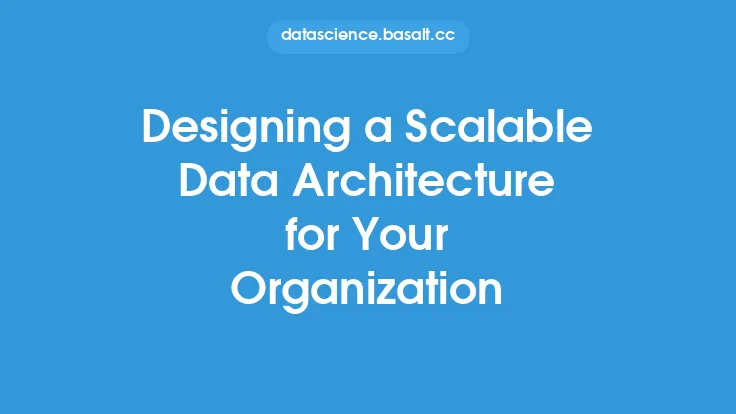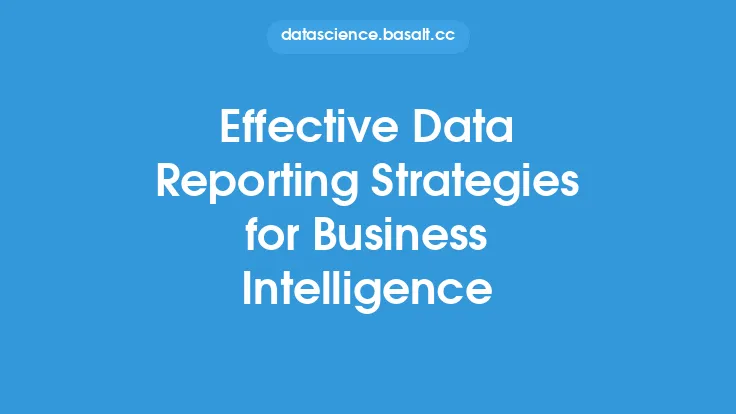In today's fast-paced business landscape, organizations are constantly evolving to stay ahead of the competition. As a result, their data architecture must also be adaptable to accommodate changing business needs. A flexible data architecture is essential for supporting the growing demands of modern businesses, enabling them to respond quickly to new opportunities and challenges. This article will delve into the importance of building a flexible data architecture, its key components, and the best practices for implementing and maintaining it.
Introduction to Flexible Data Architecture
A flexible data architecture is designed to be modular, scalable, and agile, allowing it to easily adapt to changing business requirements. It provides a foundation for managing and analyzing large volumes of data from various sources, enabling organizations to make informed decisions and drive business growth. A flexible data architecture typically consists of several layers, including data ingestion, processing, storage, and analytics. Each layer must be designed to work together seamlessly, ensuring that data flows smoothly and efficiently throughout the system.
Key Components of a Flexible Data Architecture
Several key components are essential for building a flexible data architecture. These include:
- Data Ingestion Layer: This layer is responsible for collecting data from various sources, such as social media, IoT devices, and enterprise applications. It must be able to handle large volumes of data and support multiple data formats.
- Data Processing Layer: This layer processes the ingested data, transforming it into a usable format for analysis. It may involve data cleansing, data transformation, and data aggregation.
- Data Storage Layer: This layer stores the processed data, providing a centralized repository for data management and analysis. It must be scalable and support multiple data storage formats, such as relational databases, NoSQL databases, and data warehouses.
- Data Analytics Layer: This layer provides tools and technologies for analyzing the stored data, enabling organizations to gain insights and make informed decisions. It may involve data visualization, machine learning, and predictive analytics.
Designing a Flexible Data Architecture
Designing a flexible data architecture requires careful planning and consideration of several factors, including:
- Scalability: The architecture must be able to scale up or down to accommodate changing business needs and growing volumes of data.
- Flexibility: The architecture must be able to adapt to new data sources, formats, and processing requirements.
- Interoperability: The architecture must be able to integrate with existing systems and tools, ensuring seamless data flow and minimizing data silos.
- Security: The architecture must ensure the security and integrity of the data, protecting it from unauthorized access and cyber threats.
Implementing a Flexible Data Architecture
Implementing a flexible data architecture involves several steps, including:
- Assessing Business Requirements: Understanding the organization's current and future data needs, including data sources, formats, and processing requirements.
- Selecting Technologies: Choosing the right technologies and tools for each layer of the architecture, considering factors such as scalability, flexibility, and interoperability.
- Designing the Architecture: Creating a detailed design for the architecture, including data flow, data processing, and data storage.
- Testing and Validation: Testing and validating the architecture to ensure it meets the organization's requirements and is functioning as expected.
Best Practices for Maintaining a Flexible Data Architecture
Maintaining a flexible data architecture requires ongoing monitoring, maintenance, and updates. Best practices include:
- Regularly Reviewing and Updating the Architecture: Ensuring the architecture remains aligned with changing business needs and technological advancements.
- Monitoring Data Quality and Integrity: Ensuring the accuracy, completeness, and consistency of the data, and taking corrective action when necessary.
- Providing Training and Support: Ensuring that users have the necessary skills and knowledge to effectively use the architecture and its tools.
- Continuously Evaluating and Improving: Continuously evaluating the architecture's performance and identifying areas for improvement, ensuring it remains flexible and adaptable to changing business needs.
Conclusion
Building a flexible data architecture is essential for supporting the changing needs of modern businesses. By understanding the key components, designing and implementing a flexible architecture, and following best practices for maintenance, organizations can create a robust and adaptable foundation for managing and analyzing their data. This will enable them to respond quickly to new opportunities and challenges, drive business growth, and stay ahead of the competition. As technology continues to evolve and data volumes continue to grow, a flexible data architecture will be critical for ensuring the long-term success and competitiveness of organizations.





